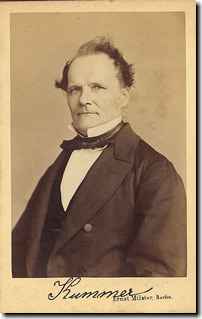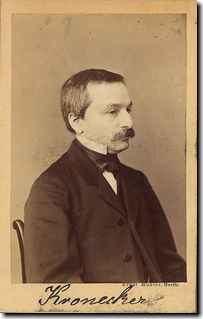<Back to Index>
- Mathematician Ernst Eduard Kummer, 1810
- Mathematician Leopold Kronecker, 1823
PAGE SPONSOR

Ernst Eduard Kummer (29 January 1810 – 14 May 1893) was a German mathematician. Skilled in applied mathematics, Kummer trained German army officers in ballistics; afterwards, he taught for 10 years in a gymnasium, the German equivalent of high school, where he inspired the mathematical career of Leopold Kronecker.
Kummer was born in Sorau, Brandenburg (then part of Prussia). Kummer was first married to Ottilie Mendelssohn, daughter of Nathan Mendelssohn and Henriette Itzig. Ottilie was a cousin of Felix Mendelssohn and his sister Rebecca Mendelssohn Bartholdy, the wife of the mathematician Peter Gustav Lejeune Dirichlet. His second wife, Bertha was a maternal cousin of Ottilie. Overall, he had 13 children. His daughter Marie married the mathematician Hermann Schwarz. Kummer retired from teaching and from mathematics in 1890 and died three years later in Berlin.
Kummer made several contributions to mathematics in different areas; he codified some of the relations between different hypergeometric series, known as contiguity relations. The Kummer surface results from taking the quotient of a two - dimensional abelian variety by the cyclic group {1, −1} (an early orbifold: it has 16 singular points, and its geometry was intensively studied in the nineteenth century). He is known also for Kummer's function, Kummer ring and Kummer sum.
Kummer also proved Fermat's last theorem for a considerable class of prime exponents (regular prime, ideal class group). His methods were closer, perhaps, to p-adic ones than to ideal theory as understood later, though the term 'ideal' arose here. He studied what were later called Kummer extensions of fields: that is, extensions generated by adjoining an nth root to a field already containing a primitive nth root of unity. This is a significant extension of the theory of quadratic extensions, and the genus theory of quadratic forms (linked to the 2-torsion of the class group). As such, it is still foundational for class field theory.

Leopold Kronecker (December 7, 1823 – December 29, 1891) was a German mathematician who worked on number theory and algebra. He criticized Cantor's work on set theory, and was quoted by Weber (1893) as having said, "God made integers; all else is the work of man". Kronecker was a student and lifelong friend of Ernst Kummer.
Leopold Kronecker was born in Liegnitz, Prussia (now Legnica, Poland) into a Jewish family. In 1845, Kronecker wrote his dissertation at the University of Berlin on number theory, giving special formulation to units in certain algebraic number fields. Peter Gustav Dirichlet was his teacher.
After obtaining his degree, Kronecker managed the estate and business of his uncle, producing nothing mathematical for eight years. In his 1853 memoir on the algebraic solvability of equations, Kronecker extended the work of Évariste Galois on the theory of equations. He accepted a professorship at Friedrich - Wilhelms University (today: Humboldt University) of Berlin in 1883.
Kronecker also contributed to the concept of continuity, reconstructing the form of irrational numbers in real numbers. In analysis, Kronecker rejected the formulation of a continuous, nowhere differentiable function by his colleague, Karl Weierstrass. In an 1850 paper, On the Solution of the General Equation of the Fifth Degree, Kronecker solved the quintic equation by applying group theory (though his solution was not in terms of radicals, since this was already proven impossible by Abel – Ruffini theorem).
Kronecker's finitism made him a forerunner of intuitionism in foundations of mathematics.
Named for Kronecker are the Kronecker limit formula, Kronecker delta, Kronecker symbol, Kronecker product, Kronecker – Weber theorem, Kronecker's method for factorizing polynomials, Kronecker's theorem in number theory, and Kronecker's lemma. He was the supervisor of Kurt Hensel, Adolf Kneser, Mathias Lerch, and Franz Mertens, amongst others.
Kronecker died on December 29, 1891 in Berlin. He is buried in the Alter St Matthäus Kirchhof Cemetery in Berlin - Schöneberg, close to Gustav Kirchhoff.